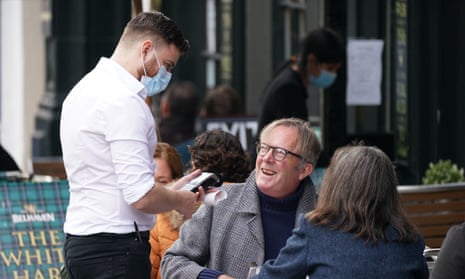The prospect of a third successive interest rate rise from the Bank of England is looming larger after news that the easing of Covid restrictions is generating growth and inflationary pressure.
Evidence of the strongest performance by the private sector since last summer left economists convinced Threadneedle Street would again increase borrowing costs when its monetary policy committee meets next month.
While most analysts predicted an interest rate rise of 0.25 percentage points to 0.75%, some said the latest snapshot of activity from the IHS Markit and the Chartered Institute of Procurement and Supply (Cips) purchasing managers’ index meant a 0.5 point move to 1% was possible.
Elizabeth Martins, a senior economist at HSBC bank, said for the Bank of England, the question may not be whether to raise rates but by how much.
“Our view is that the Bank will stick to 0.25 percentage point increments: after all, having raised rates twice and launched a quantitative tightening policy already, it is somewhat ahead of the game compared to some developed market central banks. But there is no doubt that the strength in services sector activity, expectations and input costs in this release is hawkish.”
Thomas Pugh, the UK economist at the audit and consulting firm RSM, said: “The strong February PMI reading makes it even more likely that the committee will raise interest rates from 0.5% to 0.75% at its next meeting in March; and raises the risk of a 0.5 point jump, although a 0.25 point rise is more likely.”
An indication of current thinking inside Threadneedle Street will be provided when four MPC members – including the governor, Andrew Bailey – give evidence to the Commons treasury committee on Wednesday.
The February PMI from IHS Markit/Cips showed the fastest pace of growth since last June.
Stronger consumer spending on travel, leisure and entertainment was behind a pickup in service sector activity, according to the “flash” estimate of the state of the economy.
However, the monthly health check also found growing inflationary pressures driven by higher wages, dearer energy and more expensive raw materials.
Chris Williamson, the chief business economist at IHS Markit, said: “The latest PMI surveys indicate a resurgent economy in February, as business activity leaped as Covid-19 containment measures were relaxed.
“With the PMI’s gauge of output growth accelerating markedly in February and cost pressures intensifying to the second highest on record, the odds of an increasingly aggressive policy tightening have shortened, with a third back-to-back rate rise looking increasingly inevitable in March.”
Activity in the service sector rose from 54.1 to 60.8 – the highest level since June, while manufacturing remained unchanged at 57.3. A reading above 50 suggests output is rising.
The survey said private sector companies were reporting a steep increase in incoming new work in February, with higher workloads leading to a pickup in recruitment. “Stronger client demand was widely linked to improving confidence about the UK economic outlook and rollback of pandemic restrictions,” it said.
Gabriella Dickens, a UK economist at Pantheon Macro, said: “The sharp rise in the composite PMI in February, to its highest level since June, suggests that the UK economy is rebounding from Omicron at a fair clip. The PMI was well above its average level in the second half of 2021 – 56.3 – when GDP rose by 1.0% in both the third and fourth quarters.”
